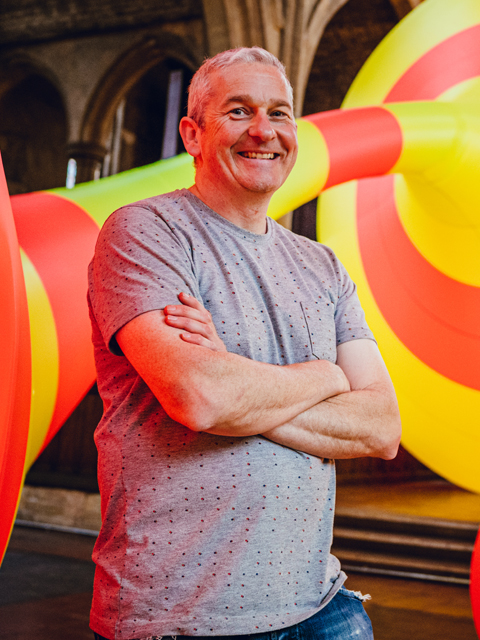Michael Shaw curates, teaches and makes sculpture. He has been the curator of Burghley Sculpture Garden since 2005, is lecturer in Fine Art at Loughborough University, whilst creating giant site-specific inflatables and sculptures in response to museum collections.
Michael Shaw is a sculptor with over 20 years professional experience, participating in multiple solo exhibitions in the UK and group shows around Europe and beyond. Complemented by various public commissions, residencies, projects and a practice-based PhD completed in 2005, which explored Donald Judd's sculptural concept: Specific Objects, his triplicate of sculptural roles complement one another and encourage his attempts to define and extend the sculptural language through practice, curation and lecturing.
Michael has held various academic positions including an AHRC Fellowship in the Creative and Performing Arts at Loughborough University 2005-2008, where he investigated the sculptural potential of CAD/CAM. He has also taught on a part time and occasional basis at various UK universities before taking his position at Loughborough in 2019.
As a curator/exhibition producer he has annually curated and installed shows at Burghley that explore the dynamics of the sculptural language, each including over 20 large scale works in the outdoor environment. This has involved him commissioning multiple artists in the production of dynamic sculptural interventions, often in unexpected locations and incorporating unusual materials. He is therefore able to work well with collaborators to deliver projects on time and within budget.
Michael's research centres on site-specific responses to architecture. The resulting inflatable sculptures seek to synthesise sculpture and architecture through direct physical interactions and by considering the building a mould that forms and informs the sculptures’ geometry. Consequently, gargantuan inflatables harmonise with or contrast their host building; moving in response to architectural structures including walls, ceilings, columns, corridors, mezzanines, lighting rigs and stairwells.
The giant inflatables seek to re-invigorate space by reconfiguring how the viewer moves around the gallery or building. Each response is wholly bespoke, and any inflatable can only exist thanks to its host architecture. The intent is to develop a meaningful interaction, whereby the sculpture reinvigorates viewers’ perceptions by complementing or contrasting the space’s geometry and flow. These universally accessible inflatables are immediately engaging for the young and family visitors; and intriguing to others as they nuance pathways of motion, block existing site-lines, create overhangs and continually curving forms that kiss the ground in limited contact points. In brief, they are sculpturally dynamic, animated works that enliven any space.
Recent venues for these gargantuan interventions include, Royal Albert Memorial Museum (RAMM), Exeter; Rugby Art Gallery and Museum (RAGM); 20-21 Visual Arts Centre, Scunthorpe; Left Bank Leeds; The Majestic, Leeds and The Hub, Sleaford.
Michael also sculpts through light, metals, ceramics and plastics; as well as dedicatedly drawing. The latter has become more painterly and of increasing scale. Many examples of all these activities can be viewed on his website.
Michael teaches on the Fine Art BA course. At the centre of his approach is an ethos personalised to each student and one that strives to help them achieve their aims. It is underpinned by his contention that the production of 'Art' requires free experimentation, courage, risk taking, commitment and effort. This is supported by extensive knowledge of contemporary art practices.
Mike is interested in supervising doctoral students whose research is articulated through Fine Art practices of all kinds, be that painterly, drawn, sculpted, printed, filmed or of a more conceptual or performative nature. Having benefited greatly from the rigours of a practice based PhD, he is keen to share his knowledge with others on how a methodical approach to artistic development can lead to exponential gains. Prospective candidates with elements of sculptural practice are particularly encouraged to get in contact.
